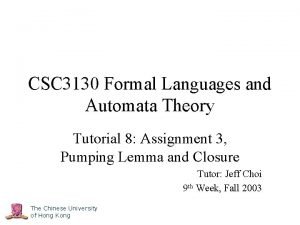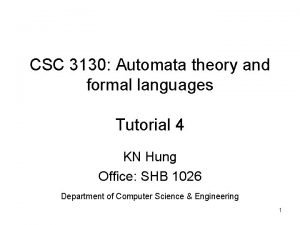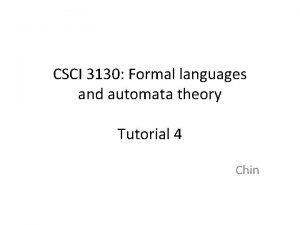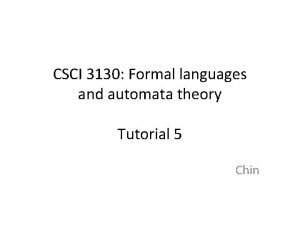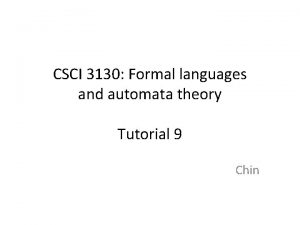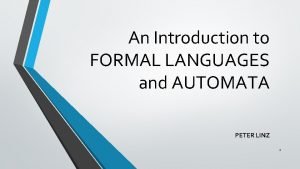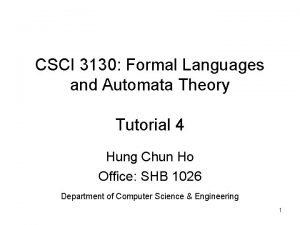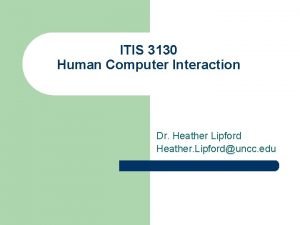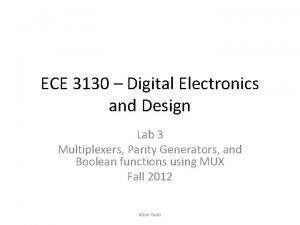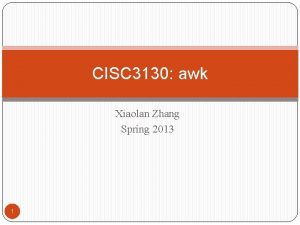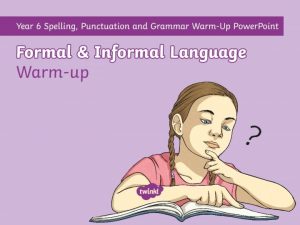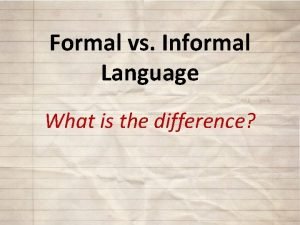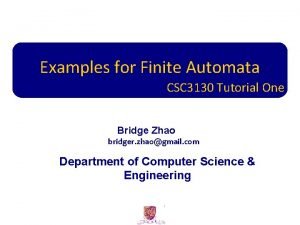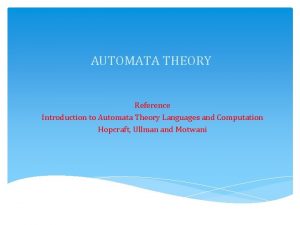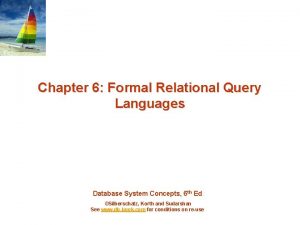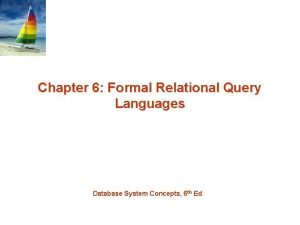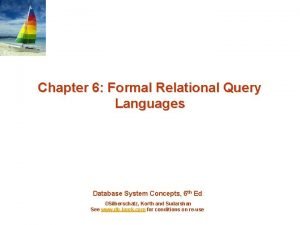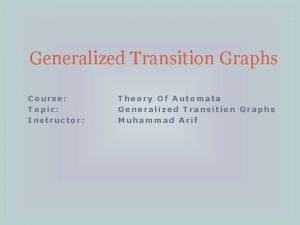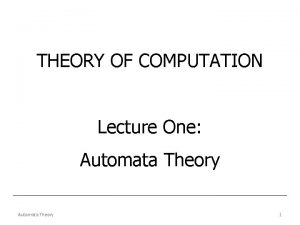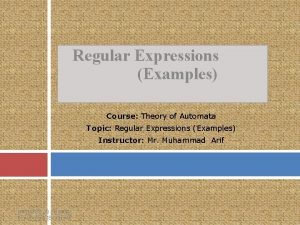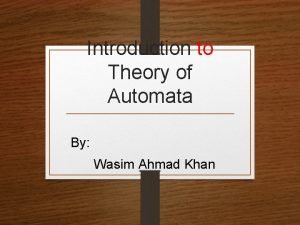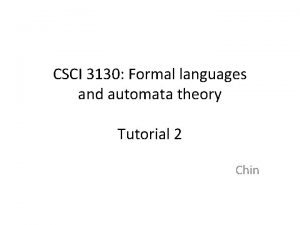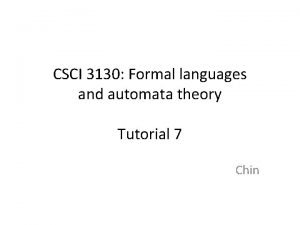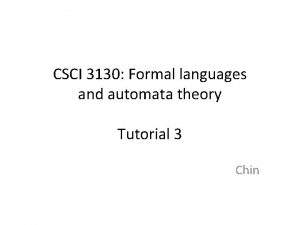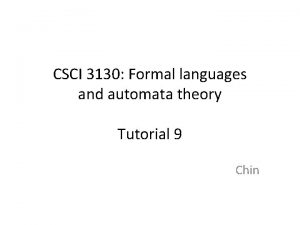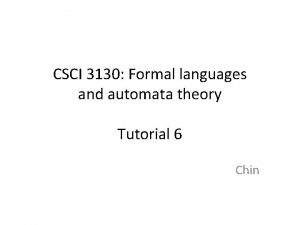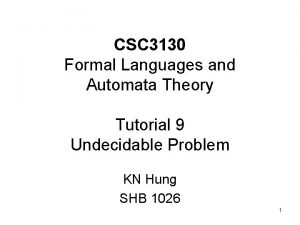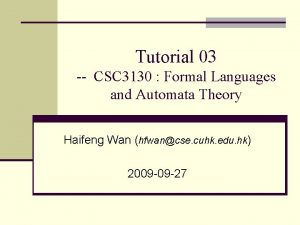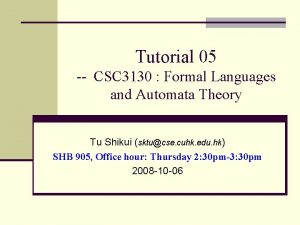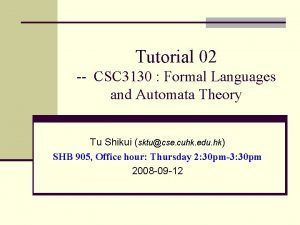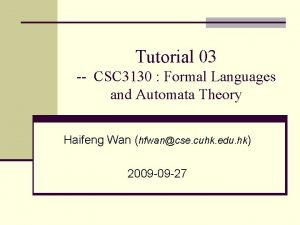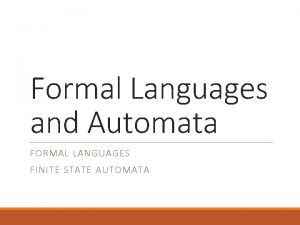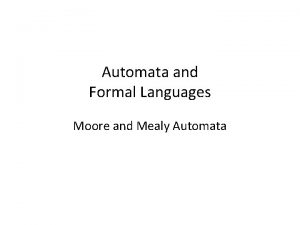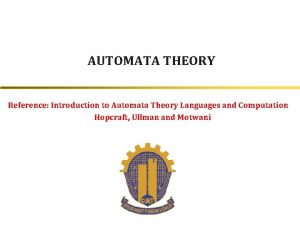CSCI 3130 Formal languages and automata theory Tutorial



























- Slides: 27

CSCI 3130: Formal languages and automata theory Tutorial 1 Lee Chin Ho

About me • Name: Chin • Office: SHB 117 • Office hour: Tuesday 11: 00 – 12: 00 • Homework 1 is due on next Thursday

Finite Automata • Finite Automata 1. Q - States 2. S - Alphabets 3. d - Transitions 4. q 0 - Initial state 5. F - Final state(s) / Accepting state(s)

Deterministic Finite Automata • There must be a transition corresponding to each alphabet at each state

Nondeterministic Finite Automata • Can be at multiple states at the same time • Can go to multiple states on one alphabet • May have no transitions on an alphabet (die)

Regular Expression • The symbols Æ and are regular expressions • Every a in S is a regular expression • If R and S are regular expressions, so are R+S, RS and R* • Remember for R*, * could be 0

Regular Languages • Languages that can be represented by a DFA / NFA / RE • DFA = NFA = RE • When asked if a language L is regular, represent L using a DFA / NFA / RE

Checklist 1. Always pay attention to S 2. For DFA, out degree of each state must be equal |S| e. g. S = {0, 1, 2}, L = {w: w begins with 01} 3. For NFA, pay attention to -transitions 4. Remember to specify the initial state 5. Make sure you have considered the input e. g. L = {w: w contains even number of 01}

Example in Lecture 1. q 2 is a “die” state 2. After a 1 has appeared, any 0 appears afterwards will die 3. 0*1* 0 q 0 1 1 q 1 0, 1 0 q 2 S = {0, 1}

Exercise S = {0, 1} L = {w: w is non-empty and the sum of the digits in w is divisible by 5}

Idea • Need to keep track of the sum of digits • Arrive at the state qk when sum of digits = k 0 q 0 0 1 q 1 0 1 q 2 0 0 1 q 3 1 q 4 0 1 q 5 …

Idea • • Need to keep track of the sum of digits Arrive at the state qk when sum of digits = k k divisible by 5 iff k mod 5 = 0 Keep track of the remainder instead 0 q 0 0 1 q 1 0 1 q 2 0 0 1 q 3 1 1 q 4

Answer • Handle the input 1 0 qs 0 q 0 0 1 q 1 0 1 q 2 0 0 1 q 3 1 1 q 4

Converting an NFA to a DFA • Eliminate q 0 for each state i q 0 for each alphabet x for each state j if i can reach j using one x and (s) add an edge from i to j with label x 0 0 q 1 q 2 0 q 0 1 q 1 q 2 1 q 0 q 1 1 q 2 1 q 3 1 q 0 q 1 1 1 q 2 q 3

Converting an NFA to a DFA • Eliminate • Remember to consider the case when the initial state can reach accepting states on (s) q 0 q 1 1 1 q 2

Converting an NFA to a DFA • Every possible subsets of Q is a state in the DFA • Going to multiple states at the same time in the NFA = going to a subset of Q, which is now a state in the DFA q 0 1 q 1 1 q 2 {q 0} 1 {q 1, q 2}

Converting an NFA to a DFA • Empty set ∅ = die S S ∅

Exercise 0 q 0 q 1 0 1 1 q 2 0, 1

Eliminating -transitions • • • q 0 can reach q 0 on 0 (q 0 -> q 1 -> q 0) q 0 can reach q 1 on 0 (q 0 -> q 1) q 1 can reach q 0 on 0 (q 1 -> q 0) q 1 can reach q 1 on 0 (q 1 -> q 1) The rest of the transitions remain unchanged 0 q 0 q 1 0 1 1 q 2 0, 1 0 1 q 0, q 1 q 2 q 1, q 2

Eliminating -transitions • q 0 is the initial state • q 0 can reach an accepting state on (i. e. q 1) • therefore q 0 is also an accepting state 0 1 q 0, q 1 q 2 q 1 0 0 q 0 q 1, q 2 q 1 0 q 0 0 1 1 q 2 0 q 1 0 0, 1 1 1 q 2 0, 1

Converting NFA to DFA 0 1 {q 0} {q 0, q 1} {q 2} {q 1} {q 0, q 1} ∅ {q 2} {q 1, q 2} 0 0 0 q 1 0 1 1 q 2 0, 1

Converting NFA to DFA • Starting from initial state {q 0} 0 1 {q 0} {q 0, q 1} {q 2} {q 1} {q 0, q 1} ∅ {q 2} {q 1, q 2} {q 0, q 1} 1 {q 2}

Converting NFA to DFA • Check if every state has |S| outgoing transitions • No • “Fix” {q 2} and {q 0, q 1} • {q 0, q 1} goes to {q 0, q 1} ∪ {q 0, q 1} = {q 0, q 1} on 0 • {q 0, q 1} goes to {q 2} ∪ ∅ = {q 2} on 1 0 1 {q 0} {q 0, q 1} {q 2} {q 1} {q 0, q 1} ∅ {q 2} {q 1, q 2} 0 {q 0} {q 0, q 1} 1 0 1 {q 1} {q 2} 0 1 {q 1, q 2}

Converting NFA to DFA • Check if every state has |S| outgoing transitions • No • “Fix” {q 1} and {q 1, q 2} • {q 1, q 2} goes to {q 0, q 1} ∪ {q 1} = {q 0, q 1} on 0 • {q 1, q 2} goes to ∅ ∪ {q 1, q 2} = {q 1, q 2} on 1 0 1 {q 0} {q 0, q 1} {q 2} {q 1} {q 0, q 1} ∅ {q 2} {q 1, q 2} 0 {q 0} {q 0, q 1} 1 1 0 0 {q 1} {q 2} 0 1 1 ∅ 0 {q 1, q 2} 1

Converting NFA to DFA • Check if every state has |S| outgoing transitions • No • “Fix” ∅ • ∅ = die 0 1 {q 0} {q 0, q 1} {q 2} {q 1} {q 0, q 1} ∅ {q 2} {q 1, q 2} 0 {q 0} {q 0, q 1} 1 1 0 0 {q 1} {q 2} 0 1 1 0, 1 ∅ 0 {q 1, q 2} 1

Converting NFA to DFA 0 • Check if every state has |S| outgoing transitions • Yes • Accepting states = states that contain q 0 or q 1 0 0 q 1 0 1 1 0, 1 q 2 0 1 {q 0} {q 0, q 1} {q 2} {q 1} {q 0, q 1} ∅ {q 2} {q 1, q 2} 0 {q 0} {q 0, q 1} 1 1 0 0 {q 1} {q 2} 0 1 1 0, 1 ∅ 0 {q 1, q 2} 1

Converting NFA to DFA • Done 0 q 0 q 1 1 q 2 {q 0} 0, 1 {q 0, q 1} 1 1 0 0 0 {q 1} {q 2} 0 1 1 0, 1 ∅ 0 {q 1, q 2} 1
 Csci3130
Csci3130 Formal languages and automata theory tutorial
Formal languages and automata theory tutorial Formal languages and automata theory tutorial
Formal languages and automata theory tutorial Automata theory tutorial
Automata theory tutorial Automata theory tutorial
Automata theory tutorial Cyk algorithm
Cyk algorithm Csci 3130
Csci 3130 Allcfg
Allcfg Gtg stands for in automata
Gtg stands for in automata Csci3130
Csci3130 Itis 3130
Itis 3130 Ece 3130
Ece 3130 Ece 3130
Ece 3130 Ece 3130
Ece 3130 Cisc 3130
Cisc 3130 Difference between formal and informal language
Difference between formal and informal language The project will be completed next year formal or informal
The project will be completed next year formal or informal Finite automata tutorial
Finite automata tutorial Central concept of automata theory
Central concept of automata theory Formal relational query languages
Formal relational query languages Find the id name dept_name
Find the id name dept_name Grouping relational algebra
Grouping relational algebra Generalized transition graph in automata
Generalized transition graph in automata Bidirectional transducers in automata theory
Bidirectional transducers in automata theory Automata theory
Automata theory Automata theory
Automata theory All words
All words Difference between valid and invalid alphabets in automata
Difference between valid and invalid alphabets in automata

